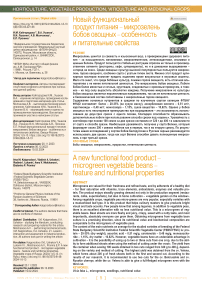Новый функциональный продукт питания - микрозелень бобов овощных - особенность и питательные свойства
Автор: Кайгородова И.М., Ушаков В.А., Луканин В.И., Молчанова А.В., Пронина Е.П.
Журнал: Овощи России @vegetables
Рубрика: Садоводство, овощеводство, виноградарство и лекарственные культуры
Статья в выпуске: 1 (75), 2024 года.
Бесплатный доступ
Микрозелень ценится за свежесть и изысканный вкус, а приверженцами здорового питания - за насыщенность витаминами, микроэлементами, антиоксидантами, энзимами и ценным белком. Продукт пользуется стабильно растущим спросом не только в производственном сегменте (рестораны, кафе, супермаркеты), но и в домашнем выращивании -«огород на окне». Среди овощных культур высокой популярностью пользуется микрозелень гороха овощного, особенно сорта с усатым типом листа. Именно этот продукт кулинарным мастерам помогает придать изделиям яркие визуальные и вкусовые акценты. Мало кто знает, что среди бобовых культур, помимо гороха овощного, есть отличная альтернатива с не менее питательной ценностью. Это микрозелень бобов овощных. Побеги бобов более мясистые и сочные, хрустящие, сладковатые с ореховым привкусом, и главное - их под силу вырастить абсолютно каждому. Получение микрозелени из культуры бобов овощных является перспективным направлением, так как ее питательная ценность и биохимический состав сопоставимы с микрозеленью гороха овощного. Содержание основных нутриентов в среднем по изученным сортам селекции ФГБНУ ФНЦО составляет: белок - 20-35% (на сухую массу), аскорбиновая кислота - 0,51 мг/г, каротиноиды - 0,48 мг/г, моносахара - 1,15%, сухое вещество - 10,62%. Однако у бобов овощных есть неоспоримое преимущество при выращивании - это возможность использования до двух-трех срезок с одного посева, благодаря способности образовывать дополнительные побеги при использовании способа срезки под «корень». Урожайность с контейнера при посеве 100 семян за две срезки составила от 320 г до 400 г в зависимости от сорта и способа срезки. Наибольшая урожайность получена у сорта Велена, который формирует около 200 г свежих побегов как в первую, так и во вторую срезку. По результатам наших исследований у сортов бобов Белорусские и Русские черные рекомендуется использовать две срезки, тогда как сорт Велена способен давать полноценную микрозелень и при третьей срезке.
Бобы овощные, микрозелень, проростки, питательная ценность
Короткий адрес: https://sciup.org/140304479
IDR: 140304479 | УДК: 635.65-021.66 | DOI: 10.18619/2072-9146-2024-1-5-13
Текст научной статьи Новый функциональный продукт питания - микрозелень бобов овощных - особенность и питательные свойства
Оригинальная статья / Original article УДК 635.65-021.66
М икрозелень – это новый специализированный продукт питания, который становится все более популярным благодаря своему богатому составу питательных веществ и разнообразию цветов, вкусов и текстур. Микрозелень это молодые побеги растений, которые используются как в пищу, так и для украшения блюд. Её используют в салатах, супах, коктейлях, смузи, других напитках и блюдах. Из-за высокого содержания полезных веществ такая пища считается очень перспективной, а её потребление неуклонно растёт. Микрозеленью называются пророщенные растения в фазе семядольных листьев, плюс один-два настоящих листа. Высота такого растения составляет от 5 до 15 см. Обычно от посева до сбора урожая проходит 5-12 дней [1].
Ученые доказали, что дальнейшая интеграция микрозелени в глобальную продовольственную систему будет встречена потребителями с высоким энтузиазмом, если будет согласована с соответствующим уровнем образованности потребителя в отношении микрозелени, а также с учетом стоимости, доступности и свежести (сроки хранения) [2]. Для этого специалисты проводят анализ рынка микрозелени, применяемых материалов и условий выращивания, а также связанные с этим затраты [3] и на основании полученных результатов расширяют сортимент и совершенствуют технологии выращивания. Так известно, что тип субстрата для производства микрозелени сильно влияет на урожайность, содержание минеральных веществ и пищевую ценность испытываемых культур. Разработка и оценка различных субстратов уже позволила получить большое их разнообразие: стандартная смесь торфа и перлита, кокосовая кора, компост из отработанных грибов, компост из органических отходов, а также их смеси и прочее [4]. При этом особое внимание уделяется не только требованиям безопасности субстрата, но и скринингу устойчивости микрозелени к бактериальным патогенам во время выращивания [5].
Разрабатываются и совершенствуются системы выращивания микрозелени – стеллажные, ярусные и вертикальные фермы (гидропонные системы) [6]. Продолжая совершенствование этих технологий производства, испытываются различные составы питательного раствора, позволяющие снизить содержание нитратов в листовых овощах без негативного влияния на урожайность и его качество [7]. Например, благодаря частичной замене удобрений на основе нитратов удобрениями на основе аммония [8]. Для улучшения роста побегов и корней микрозелени и увеличения содержания хлорофиллов и каротиноидов в зеленой массе используют росторегулирующие препараты [9].
Получение высококачественных продуктов из свежих проростков также связанна с интенсивностью света при выращивании микрозелени. Процесс проектирования освещения для каждой культуры индивидуальный и основывается на определении реакции растений на свет в модельных и производственных условиях. Подбирается оптимальный спектр и регулируется мощность светодиодных светильников [10;11]. Обнаружено положительное влияние дополнительного кратковременного красного светодиодного освещения (с длиной волны 638 нм) на предуборочном этапе (в течение трех дней), что приводит к увеличению антиоксидантных свойств микрозелени [12].
Короткий срок хранения ограничивает коммерческую ценность любого продукта. Определить оптимальную температуру хранения для микрозелени необходимо, чтобы она дольше сохраняла свои органолептические свойства [13]. Установлено, что температура хранения +5°C в полиэтиленовых пакетах толщиной 150 мкм позволяет сохранить высокое качество в течение 14 дней [14, 15].
Осознавая высокую питательную ценность различных культур и сортов микрозелени (16-19), ее широко применяют в кулинарии (20, 21). Помимо этого, исследованиями доказано, что микрозелень обладает противовоспалительными, противораковыми, антибактериальными и антигипергликемическими свойствами, что и делает ее новым функциональным продуктом питания, полезным для здоровья человека [22].
В рамках программы биофортификации ученые проводят исследования по обогащению и увеличению концентрации питательных микроэлементов в растениях (например, йода, цинка и селена) (23, 24). Несмотря на богатый элементный состав и высокую питательную ценность свежую микрозелень также дополнительно насыщают различными микроэлементами [4, 25].
Увеличение потребления микрозелени и расширение ассортимента видов, используемых для производства микрозелени, может не только положительно повлиять на рацион питания, но и обеспечить экономическое будущее микрозелени [26, 27]. Микрозелень можно рассматривать как устойчивую фитохимическую фабрику для удовлетворения диетических и психологических потребностей членов экипажей космических орбитальных станций. Такие растения могут обеспечивать космонавтов пищей, они подходят для расширения разнообразия космических культур, поскольку имеют короткий цикл выращивания [28].
В качестве микрозелени выращивают как традиционную зелень: салат, лук, бораго, укроп, петрушку, кинзу и прочие пряные травы, так и растения, в качестве зелени используемые редко: редис, дайкон, свёклу, или не используемые вообще: злаки, амарант, подсолнечник, нут, капусту, горох. Однако, еще мало кто знает, что также для получения питательной микрозелени можно использовать культуру – бобы овощные [29].
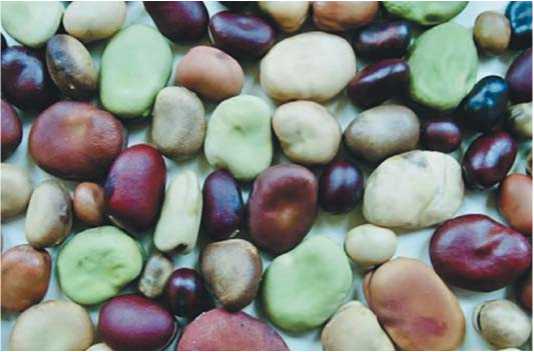
Рис. 1. Различные типы семян Vicia faba L.
Fig. 1. Various types ofseeds ofVicia faba L.
Бобы овощные ( Vicia faba L.) – это одна из древнейших овощных культур, известная еще под названиями конские бобы или фасоль Фаба [30]. Генетическая изменчивость вида достаточно велика и часто описывается на основе различий по массе, форме и размеру семян. Только по этому признаку есть описание четырех ботанических типов этой культуры [31-33]. Размер семян зависит от потребностей рынка: крупносеменные сорта широко используются в пищу, как свежий зеленый овощ и как сухие семена, а мелкосеменные в основном выращивают на корм животным и птицам (рис.1). Ряд обзоров посвящён питательной ценности бобовых культур, в том числе и бобам [34-37].
В России к бобам овощным относят сорта с крупными семенами, которые обладают высокой питательной ценностью. Среди бобовых культур они имеют наибольшее содержание белка в семенах (от 24 до 35%), благодаря чему их пищевое значение все больше возрастает [38, 39]. В семенах бобов также содержится до 55% углеводов и 1,5% жиров. Бобы ценятся не только за высокое содержание белка, но и за его хорошую усваиваемость. Также за содержание в них незаменимых аминокислот: аргинин, гистидин, метионин, лизин и др., большого количества витаминов (В 1 , В 2 , В 6 , РР, С, К, Е), каротина, пантотеновой, фолиевой кислот, а также минеральных солей калия, кальция, фосфора, магния, серы и железа [40, 41]. Энергетическая ценность 100 г свежих семян бобов (молочная спелость) составляет 60-90 ккал, а в зрелых семенах – в три-четыре раза выше. По калорийности бобы превышают в три раза картофель и в шесть раз капусту. Семена бобов можно употреблять в свежем (молочная спелость), сухом, замороженном и переработанном виде. В кондитерской промышленности бобы заменяют орехи и из бобов готовят снеки.
Растения и семена бобов овощных с древних времен используют в медицине и косметологии. Употребление их предупреждает нарушение обмена веществ и связанных с ним заболеваний, регулирует работу кишечника и способствуют выведению токсинов. В бобах обнаружено вещество – убихинон, обладающий массой полезных свойств, например, помогает при сердечнососудистых заболеваниях и нарушениях обменных процессов в организме [42]. Убихинон добавляют в крем от морщин, а древние римлянки накладывали на лицо маску из размолотых бобов. Отваром или настоем цветков умывали или протирали кожу лица для снятия раздражения и зуда. При употреблении в пищу, несмотря на множество полезных свойств, у бобов есть и противопоказания: семена могут содержать различные концентрации антипитательных веществ – танинов, вицина и конвицина [38, 43, 44]. Белая окраска цветков и светлый рубчик семян – маркерные признаки, свидетельствующие об отсутствии или низком содержании в семенах этих веществ [45].
Однако, несмотря на все достоинства, бобы овощные в нашей стране пока мало востребованы [46]. Объяснить это можно недооценкой пищевых качеств культуры. Одним из способов увеличения востребованности бобов овощных – использование как совершенно нового продукта питания в виде микрозелени и включение ее в блюда для повышения содержания питательных элементов. При этом, в отличие от самих семян, проти- вопоказаний при употреблении микрозелени бобов пока нет, так как с этой точки зрения они мало изучены.
Производство бобов овощных ( faba beans dry – сухое зерно) по данным ФАО (2021 год) в мире составило более 5,96 млн т, производственные посевы располагались на площади более 2,72 млн га. Лидерами по производству зерна (семян) бобов в 2021 году являлись: Китай (1,7 млн т), Эфиопия (1,1 млн т), Великобритания (694,3 тыс. т), Австралия (509,7 тыс. т) и Пакистан (235,9 тыс. т). Посевные площади в Российской Федерации незначительны, более 4,4 тыс.га, производство – 7,5 тыс.т. Производство бобов овощных ( faba beans green – зеленые бобы) в мире составило более 1,73 млн т, производственные посевы располагались на площади более 277,4 тыс.га. Лидерами по производству зеленых бобов в 2021 году стали: Алжир (277,3 тыс.т.), Египет (190,9 тыс.т.), Китай (114,8 тыс.т.), Польша (88,5 тыс.т.) и Тунис (83,6 тыс.т.) [47]. По посевным площадям для производства зеленых бобов в Российской Федерации статистических данных нет.
Агротехническое значение бобов состоит в том, что они, как и другие бобовые культуры, являются хорошим предшественником для многих культур [48, 49], благодаря своей высокой азотфиксирующей способности, которая составляет около 160 кг/га [50]. Поэтому бобы особенно рекомендуют для выращивания в севообороте. В европейских странах с более мягким зимним климатом определенные сорта бобов выращивают в озимой культуре [51-54].
В лаборатории селекции и семеноводства овощных бобовых культур ФГБНУ ФНЦО создаются сорта бобов овощных для различного направления использования – употребления бобов и семян в свежем виде и переработки. Однако, оценку этих сортов для использования в технологиях производства микрозелени не проводили. В связи с этим целью данных исследований стало оценить содержание питательных веществ в свежих проростках культуры бобы овощные и оценить продуктивность свежей микрозелени сортов селекции ФГБНУ ФНЦО.
Материал и методы
В Федеральном научном центре овощеводства в результате многолетней селекционной работы созданы сорта бобов овощных [55] с различной окраской семян (рис. 2).
Сорт Белорусские. Позднеспелый. Высота растения 60-100 см, стебель ветвится слабо. Цветки белые с коричневыми прожилками на парусе и темными пятнами на крыльях. Первый боб завязывается на 6-7 узле. Боб прямой, длина 8-11 см, ширина 2 см, число бобов на растении 6-10. поверхность бобов гладкая, сетчатая, окраска в съемной спелости темно-зеленая. Плоды при созревании растрескиваются, 3-4-семянные. Семена удлиненно-овальные, светло-коричневые, со временем буреющие. Масса 1000 семян 1800 г. Товарная урожайность семян 4,9 т/га, зеленых бобов – 11,5-13,0 т/га.
Сорт Велена. Среднеранний. Стебель прямостоячий, высотой 80-100 см, слабоветвистый. Число непродуктивных узлов 5-8, продуктивных – 5-6, высота прикрепления нижнего боба 30-33 см. Лист сложный, с 3-4 парами листочков округлой формы, темно-зеленой

Белорусские cv.Belorusskie
Велена cv. Velena
Русские черные cv. Russkie chernye
Рис. 2. Семена бобов овощных различных сортов селекции ФГБНУ ФНЦО Fig. 2. Seeds ofvegetable beans ofvarious varieties ofbreeding ofFSBSIFSVC
окраски. Число цветков в кисти 6-8. Цветок крупный, белый, с черным бархатным пятном на крыльях. Первый боб завязывается на 5-8 узле. Боб сахарный, без пергаментного слоя, длиной 10-12 см, шириной 2 см, толщиной 1,2 см, слегка изогнутый, тупоконечный, 3-4-семяный. Поверхность морщинистая с редким опушением, окраска в съемной спелости темно-зеленая. Семена округло-угловатые, светло-палевые. Масса 1000 семян 1400 г. Применяют в пищу в виде зеленых бобов, недозрелых зерен и созревших сухих семян для приготовления различных блюд и консервирования. Товарная урожайность семян – 5,6 т/га, зеленых бобов – 11,5-17,5 т/га.
Сорт Русские черные. Раннеспелый. Высота растений 50-60 см, стебель ветвится, образуя 1-2, иногда 3 ветви. Цветки белые с фиолетовыми прожилками на парусе и темными пятнами на крыльях. На растении завязывается от 6 до 16 бобов. первый боб завязывается на 5-6 узле. Бобы слегка изогнутые, морщинистые, длина боба 7-8 см, ширина 1,5-2,0 см. При созревании бобы не растрескиваются, 2-3-семянные. Семена удлиненно-овальные, темно-фиолетовые. Товарная урожайность 5,0 т/га, зеленых бобов – 11,014,0 т/га.
Семена испытуемых сортов селекции ФГБНУ ФНЦО после десятичасового замачивания укладыва- ли на грунт в контейнер, мульчируя слоем один сантиметр. Проращивали в термостате под прессом до появления всходов при температуре +15°C. После появления всходов на пятые сутки переносили в оранжерейные условия. Через 14 суток проводили первую срезку, еще через три недели – вторую (под корень – на уровне грунта; под «пень» – три-пять сантиметров от уровня грунта; рис. 3).
Показатели продуктивности определяли путем взвешивания каждого учетного растения. Биохимические исследования проводили согласно принятым методикам: содержание сухого вещества определяли гравиметрически после высушивания образцов при 70°C до постоянной массы; содержание аскорбиновой кислоты устанавливали по методике Сапожниковой, Дорофеевой [56]; содержание белка в семенах определяли по Бредфорду, 1976 [57], белок экстрагировали буферным раствором (pH 8,0), с небольшой модификацией, калибровку осуществляли по бычьему сывороточному альбумину (99%) фирмы «Диаэм» (Россия); содержание моносахаров проводили цианидным методом (метод Сабуровой, Копериной). Для определения содержания каротиноидов брали навески каждого образца, экстрагировали 96% этанолом и результат вычисляли на спектрофотометре с использованием методики Lichtenthaler et al. (1987) [58].
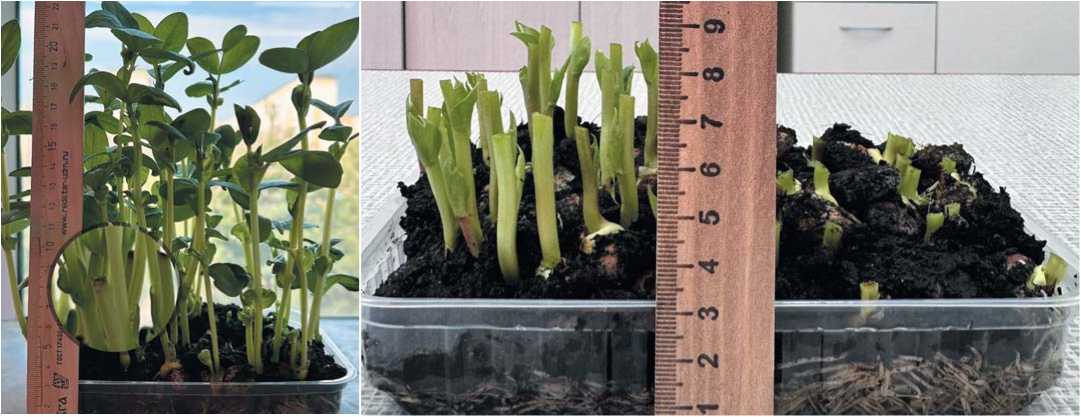
Рис. 3. Варианты срезки проростков бобов овощных Fig. 3. Options for cutting vegetable bean microgreens

Рис. 4. Микрозелень бобов овощных Fig. 4. Microgreen vegetable beans
Статистическую обработку экспериментальных данных проводили с помощью прикладных программ Microsoft Office Excel.
Результаты и обсуждение
В ФГБНУ «Федеральный научный центр овощеводства» проведено сравнительное испытание различных сортов бобов овощных при различных элементах технологии выращивания проростков и сравнительная оценка питательной ценности проростков гороха и бобов овощных. Микрозелень бобов – это свежесрезанные побеги высотой около 10-15 см (рис. 4).
Стебель четырехгранный, мясистый. Листочки крупные, эллиптические, неопушенные, мясистые, сизо-зеленые, цельнокрайние, нижние листья одно- парные, затем 2-3-4х парные. Вкус сладковатый с ореховым привкусом.Такие побеги можно употреблять в пищу самостоятельно или использовать как компонент для приготовления салатов, смузи или в виде съедобного украшения. Установлено, что микрозелень бобов овощных не содержит никаких вредных веществ, поэтому для ее выращивания можно использовать любые сорта,не зависимо от окраски их семян.При этом,благодаря способности быстро формировать вторичные побеги,можно получать дополнительный урожай микрозелени. Для выявления оптимального способа срезки с целью большего выхода продукции срезку проводили двумя путями: первый способ – под корень (на уровне грунта) и второй способ – оставляя «пень» размером не более пяти сантиметров (рис. 4).


Белорусские cv.Belorusskie
Русские черные cv. Russkie chernye
Велена cv. Velena
Рис. 5. Морфометрическая оценка проростков бобов овощных на разных стадиях развития: через неделю после посева и через две недели при первой срезке Fig. 5. Morphometric assessmentofvegetable bean microgreens atdifferentstages ofdevelopment:a week after sowing and two weeks after the first cut
Таблица 1. Морфометрические параметры проростков бобов овощных Table 1. Morphometric parameters of vegetable bean microgreens
|
Первая срезка |
Вторая |
срезка* |
||||||
|
Сорт |
масса побега, г |
высота побега, см |
масса побега, г |
высота проростка, см |
доля проростков с доп. побегами, |
|||
|
1 способ |
2 способ |
1 способ |
2 способ |
1 способ |
2 способ |
|||
|
Белорусские, st. |
2,2 |
16,1 |
1,3 |
1,6 |
11,1 |
10,7 |
70 |
50 |
|
Русские черные |
1,7 |
11,8 |
1,6 |
1,7 |
9,3 |
8,6 |
60 |
60 |
|
Велена |
1,9 |
12,3 |
2,1 |
2,1 |
14,0 |
13,7 |
100 |
10 |
|
НСР 05 |
0,1 |
1,2 |
0,2 |
0,1 |
1,2 |
1,3 |
10 |
13 |
* 1 способ - под корень; 2 способ - под «пень»
* 1 way - under the root; 2 way - under the «stump»
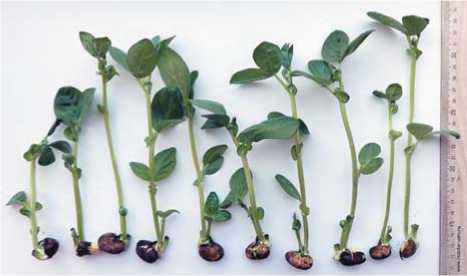
под корень under the root
Рис. 6. Формирование вторичных побегов при разных способах срезки проростков у сорта Велена Fig. 6.Formation of secondary shoots with differentmethods ofcutting microgreensin the cv. Velena
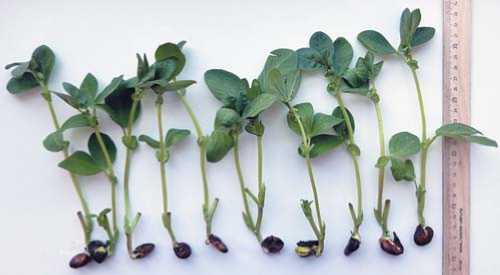
под «пень» under the «stump»
Сравнительная характеристика ростовых параметров проростков бобов овощных различных сортов выявила существенную разницу между выбранными сортами по силе роста уже на ранних этапах прорастания семян (рис. 5).
Двухнедельные проростки имели массу растения 1,7-2,2 г при высоте 12-16 см в зависимости от сорта. Наиболее развитые проростки к моменту первой срезки имели проростки сорта Белорусские, наименее – Русские Черные (табл. 1).
Во вторую срезку через три недели, после первой, растения сформировали побеги уже массой 1,3-2,1 г в зависимости от сорта и способа срезки.Побеги бобов сорта Белорусские при срезке под корень смогли через три недели образовать побеги со средней массой на 41% ниже, чем масса побега при первой срезке и на 27% ниже, чем при срезке под «пень». У других сортов разницы не обнаружено как при первой и второй срезке, так и при различных вариантах срезки. Высота побегов в первую и вторую срезку у сортов различалась. У сорта Белорусские во вторую срезку их рост снизился более чем на 30%, независимо от способа срезки. У сорта Русские черные показатель высоты проростка во вторую срезку снизился на 21% при срезке под корень и на 27% при срезке под «пень». Однако у сорта Велена проростки к моменту второй срезки смогли сформировать высоту на 11-14% выше относительно первой срезки в зависимости от способа ее проведения (табл. 1).
Способность образовывать дополнительные побеги к основному при срезке под корень выше, чем при срезке под пень до пяти сантиметров. Проводя морфо- метрическую оценку, было выявлено, что у сорта Велена при срезке под корень растения в 100% случаях образует второй побег (табл. 1, рис. 6). Так как дополнительный побег имеет небольшие размеры его можно будет использовать позднее для третьей срезки. У сортов Белорусские и Русские черные вероятность образования побега равна 70% и 60%, поэтому использовать их для трех срезок не рекомендуется.
Урожайность микрозелени зависит от посевных качеств семян. Высокие показатели всхожести используемого посевного материала при оптимальных условиях залог получения максимального урожая с высоким качеством (рис. 7).
За одну срезку (первую) выход свежих побегов с контейнера (100 семян) составил от 150 г до 201 г в зависимости от сорта семян и их посевных качеств. Во вторую срезку у сорта Велена выход продукции при разных способах срезки был одинаковым, тогда как у сор-
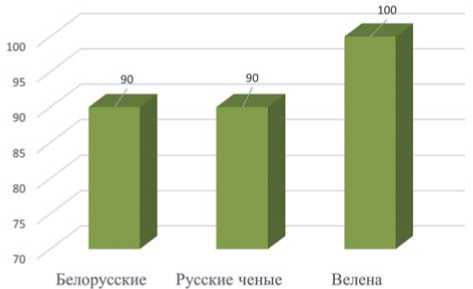
Рис. 7.Лабораторная всхожесть бобов овощных, %
Fig. 7. Laboratory germination ofvegetable beans, %
Таблица 2. Урожайность проростков бобов овощных с контейнера, кг Table 2. Yield of vegetable bean microgreens per container, kg
|
Сорт |
Первая срезка |
Вторая срезка* |
За две срезки |
||
|
1 способ |
2 способ |
1 способ |
2 способ |
||
|
Белорусские, st. |
0,201 |
0,116 |
0,145 |
0,317 |
0,346 |
|
Русские черные |
0,150 |
0,143 |
0,153 |
0,293 |
0,303 |
|
Велена |
0,185 |
0,210 |
0,207 |
0,395 |
0,392 |
|
НСР 05 |
0,014 |
0,020 |
0,012 |
0,017 |
0,015 |
* 1 способ – под корень; 2 способ – под «пень» [* 1 way - under the root; 2 way - under the «stump»]
Таблица 3. Сравнительная характеристика питательной ценности проростков овощных бобовых культур (средние показатели у сортов селекции ФГБНУ ФНЦО)
Table 3. Comparative characteristics of the nutritional value of vegetable legumes microgreens (average values of the varieties of selection of FSBSI FSVC)
|
Культура |
Сухое вещество, % |
Аскорбиновая кислота, мг/г |
Каротиноиды, мг/г |
Моносахара, % |
Белок, % на сухую массу |
Полифенолы, мг-экв Гк/г сух. м. |
ССА в спиртовом экстракте мг-экв Гк/г сух. м. |
|
Бобы овощные |
10,62 |
0,51 |
0,48 |
1,15 |
20-40 |
26,82±0,41 |
58,58±2,89 |
|
Горох овощной |
11,33 |
0,47 |
0,38 |
1,12 |
20-25 |
16,52±1,29 |
23,20±2,42 |
|
НСР 05 |
0,90 |
0,05 |
0,08 |
0,05 |
- |
- |
- |
тов Русские черные и Белорусские срезка с оставлением «пня» дала выход продукции на 7% и 25% выше. Однако, несмотря на то что в варианте с оставлением «пня» выход продукции при второй срезке был немного выше, за две срезки результаты были сопоставимы. Наибольший выход продукции из изученных сортов получен у сорта Велена – за две срезки почти 400 г молодых проростков – по 200 г за каждую срезку (табл. 2).
Для сравнения питательной ценности проростков бобовых овощных был проведен биохимический анализ проростков гороха и бобов овощных. Оказалось, что проростки бобов по питательной ценности не уступают проросткам гороха (табл. 3).
Так, содержание аскорбиновый кислоты, каротиноидов и белка в проростках бобов было вышесоответ-ственно на 9%, 26% и в 1,5-2,0 раза относительно проростков гороха, при сравнимом накоплении сухого вещества и моносахаров у этих культур. Кроме того, содержание полифенолов и суммы антиоксидантов в спиртовом экстракте в бобах составляет 26,82 мг-экв Гк/г сух. массы и 58,58±2,89 мг-экв Гк/г сух. массы соответственно, что в 1,6-2,5 раза выше, чем в горохе овощном.
Меньше всего сухого вещества среди сортов бобов обнаружено у сорта Белорусские – 8,67%, у двух других сортов содержание сухого вещества было одинаковым и составило примерно 11,5%. Накопление аскорбиновой кислоты больше выше в проростках сорта Русские черные – 0,58 мг/г, а в сортах со светлой окраской семян было одинаковым и составило 0,48 мг/г (рис. 8).
Заключение
Таким образом, получение микрозелени из культуры бобов овощных является перспективным направлением, так как питательная ценность этой культуры сопоставима с питательной ценностью гороха овощного. Среднее накопление биохимических веществ по сортам составило: сухое вещество – 10,62%, аскорбиновая кислота – 0,51 мг/г, каротиноиды – 0,48 мг/г, моносахара – 1,15%, белок – 2040% (на сухую массу). Однако у бобов овощных есть неоспоримое преимущество – это возможность использования до двух-трех срезок при выращивании. Так, у сорта Белорусские и Русские черные рекомендуется использовать две срезки, у сорта Велена – до трех срезок, благодаря способности образовывать дополнительный побег при
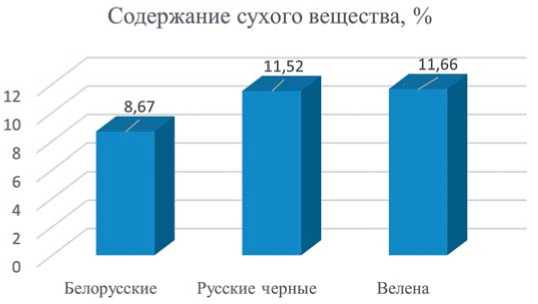
Рис. 8. Биохимические параметры в проростках разных сортов бобов овощных Fig. 8.Biochemical parameters in seedlings of different varieties ofvegetable beans
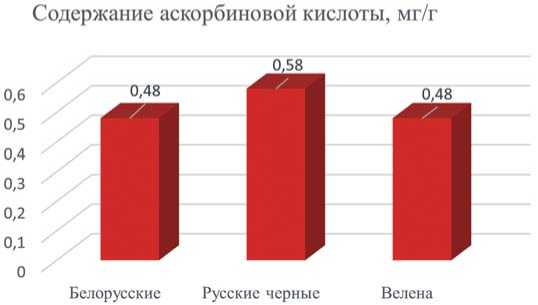

подготовка семян seed preparation первая срезка firstcut вторая срезка second cut упакованный продукт packaged product
Рис. 9. Выращивание микрозелени бобов овощных сорт Велена в производственных условиях Fig. 9.Cultivation ofmicrogreens ofvegetable beans ofthe cv. Velena in production conditions
использовании способа срезки под корень. Наибольшая урожайность с контейнера при посеве 100 семян получена у сорта Велена. При использовании семян этого сорта можно получать около 200 г свежих побегов в первую и во вторую срезку.
Семена сорта Велена были переданы на производственные испытания нескольким компаниям по производству микрозелени, где культура и сорт получили высокую технологическую оценку и были отмечены высокие вкусовые качества продукта (рис. 9).
На основании этого, можно утверждать, что выращивание микрозелени бобов овощных является перспективным направлением с высокой конкурентоспособностью. Элементы технологии производства, технические и пищевые стандарты микрозелени бобов овощных в настоящее время находятся в процессе разработки, после чего этот продукт с нашей точки зрения должен получить широкое признание у производителей и потребителей.
Производственный интерес на рынке свежей микрозелени также вызывает один из новых сортов бобов овощных – Русские белые, благодаря своим параметрам. Особую ценность вызывают такие признаки как светлые семена со светлым рубчиком и высокими вкусовыми качествами (рис. 10).

Рис. 10. Семена бобов овощных, сорт Русские белые Fig. 10. Vegetable bean seeds, cv. Russkie belye
Русские белые. Сорт среднеспелый. Включён в Госреестр по Российской Федерации для выращивания в ЛПХ. Рекомендуется для использования семян в фазе молочной спелости в домашней кулинарии. Растение средней высоты – высокое, малооблиственное. Лист зелёный, листочек среднего размера. Цветки среднего размера, меланиновое пятно на крыльях имеется, на парусе – отсутствует. Боб длинный, широкий, прямой, зелёный. Высота прикрепления нижнего боба – 35 см. Семена в продольном сечении яйцевидные, в поперечном - узкоэллиптические, бежевые, очень крупные, без чёрного рубчика. Вкусовые качества отличные. Урожайность семян – 6,0 т/га, зеленых бобов – 14,0-17,0 т/га.
Список литературы Новый функциональный продукт питания - микрозелень бобов овощных - особенность и питательные свойства
- Гавриш. Профессиональные семена. https://gavrishprof.ru/info/publications/vsyo-chto-vy-hoteli-znat-ovyrashchivanii-mikrozeleni-doma. (дата обращения (10.11.2023 год). [Gavrish. Professional seeds. https://gavrishprof.ru/info/publications/vsyochto-vy-hoteli-znat-o-vyrashchivanii-mikrozeleni-doma. (accessed (10.11.2023). (In Russ.)].
- Michell K.A., Isweiri H., Newman S.E., Bunning M. еt al. Microgreens: consumer sensory perception and acceptance of an emerging functional food crop. Food Science. 2020;(85):926-935.
- Enssle N. Microgreens: market analysis, growing methods, and models august. California State University, San Marcos. 2020. 27р.
- Poudel P., Duenas A.E.K., Gioia F.D. Organic waste compost and spent mushroom compost as potential growing media components for the sustainable production of microgreens. Front Plant Sci. 2023;(14):1229157. https://doi.org/10.3389/fpls.2023.1229157.
- Deng W., Misra G.M., Baker C.A., Gibson K.E. Persistence and transfer of foodborne pathogens to sunflower and pea shoot microgreens during production in soil-free cultivation matrix. Horticulturae. 2021;7(11):446. https://doi.org/10.3390/horticulturae7110446.
- Ciuta F., Arghir L.D., Tudor C.A., Lagunovschi-Luchian V. Research on microgreens farming in vertical hydroponic system. Journal of Horticulture, Forestry and Biotechnology. 2020;24(4):27-34.
- Palmitessa O.D., Renna M., Crupi P., Lovece A. еt al. Yield and quality characteristics of Brassica microgreens as affected by the NH4:NO3 molar ratio and strength of the nutrient solution. Foods. 2020;(9):667. https://doi.org/10.3390/foods9050677.
- Santamaria P., Gonnella M., Elia A., Parente A., Serio F. Ways of reducing rocket salad nitrate content. Acta Hortic. 2001;(548)64:529-536. https://doi.org/10.17660/ActaHortic.2001.548.64.
- Tsygankova V.A., Andrusevich Y.V., Kopich V.M., Voloshchuk I.V. еt al. Effect of pyrimidine and pyridine derivatives on the growth and photosynthesis of pea microgreens. Int J Med Biotechnol Genetics. 2023;S1:02:003:15- 22.
- Truzzi F., Whittaker A., Roncuzzi C., Saltari A. Microgreens: functional food with antiproliferative cancer properties in-fluenced by light. Foods. 2021;10(8):1690. https://doi.org/10.3390/foods10081690.
- Balazs L., Kovacs G.P., Gyuricza C., Piroska P. еt al. Quantifying the effect of light intensity uniformity on the crop yield by pea micro-greens growth experiments. Horticulturae. 2023;9(11):1187. https://doi.org/10.3390/horticulturae9111187.
- Samuolienė G., Brazaitytė A., Sirtautas R., Sakalauskienė S. еt al. The impact of supplementary short-term red led lighting on the antioxidant properties of microgreens. Acta Hortic. 2012;(956)78:649-656. https://doi.org/10.17660/ActaHortic.2012.956.78.
- Paradiso V.M., Castellino M., Renna M., Gattullo C.E. еt al. Nutritional characterization and shelf-life of packaged microgreens. Food Funct. 2018;(9):5629-5640. https://doi.org/10.1039/C8FO01182F.
- Dalal N., Siddiqui S., Phogat N. Post-harvest quality of sunflower microgreens as influenced by organic acids and ethanol treatment. Journal of Food Processing and Preservation. 2020;(44)9:e14678. https://doi.org/10.1111/jfpp.14678.
- Dayarathna N.N., Gama-Arachchige N.S., Damunupola J.W., Xiao Z. еt al. Effect of storage temperature on storage life and sensory attributes of packaged mustard microgreens life. Life (Basel). 2023;13(2):393. https://doi.org/10.3390/life13020393.
- Ушакова О.В., Молчанова А.В., Котляр И.П. и др. Исследование биохимической ценности проростков гороха овощного (Pisum sativum L.). Сборник трудов конференции «Зернобобовые культуры, развивающееся направление в России». ФГБОУ ВО Омский ГАУ. 2018. С. 202-206. EDN UUSMNA. [Ushakova O.V., Molchanova A.V., Kotlyar I.P., etc. Investigation of the biochemical value of vegetable pea seedlings (Pisum sativum L.). Collection of works of the conference «Leguminous crops, a developing trend in Russia». FSBSI HE Omsk SAU. 2018. P. 202-206. (In Russ.)].
- Ghoora M.D., Babu D.R., Srividya N. Nutrient composition, oxalate content and nutritional ranking of ten culinary microgreens. Journal of Food Composition and Analysis. 2020;(91):103495. https://doi.org/10.1016/j.jfca.2020.103495.
- Renna M., Paradiso V.M. Ongoing research on microgreens: nutritional properties, shelf-life, sustainable production, innovative growing and processing approaches. Foods. 2020;(9:826. https://doi.org/10.3390/foods9060826.
- Lenzi A., Orlandini A., Bulgari R., Ferrante A., Bruschi P. Antioxidant and mineral composition of three wild leafy species: A comparison between microgreens and Baby greens. Foods. 2019;(8):487. https://doi.org/10.3390/foods8100487.
- Блюда с микрозеленью. https://babiesgreen.ru/blyuda-s-mikrozelenyu. [Dishes with micro greenery. https://babiesgreen.ru/blyuda-s-mikrozelenyu. (In Russ.)].
- Renna M., Di Gioia F., Leoni B., Mininni C., Santamaria P. Culinary assessment of self-produced microgreens as basic ingredients in sweet and savory dishes. J. Culin. Sci. Technol. 2017;(15):126-142. https://doi.org/10.1080/15428052.2016.1225534.
- Zhang Y., Xiao Z., Ager E., Kong L., Tan L. Nutritional quality and health benefits of microgreens, a crop of modern agriculture. Journal of Future Foods. 2021;(1)1:58-66. https://doi.org/10.1016/j.jfutfo.2021.07.001.
- Blair M.W., Astudillo C., Grusak M.A., Graham R., Beebe S.E. Inheritance of seed iron and zinc concentrations in common bean (Phaseolus vulgaris L.). Molecular Breeding. 2009;(23):197-207.
- Carvalho L.M., Corrêa M.M., Pereira E.J., Nutti M.R. еt al. Iron and zinc retention in common beans (Phaseolus vulgaris L.) after home cooking. Food & Nutrition Research. 2012;(56):1-6. https://doi.org/10.3402/fnr.v56i0.15618.
- Ушакова О.В., Голубкина Н.А., Кошеваров А.А. и др. Влияние обогащения селеном на элементный состав проростков овощных бобовых культур: Vicia faba L., Phaseolus vulgaris L., Pisum sativum L. В сборнике: Биогеохимия - научная основа устойчивого развития и сохранения здоровья человека. труды XI Международной биогеохимической школы, посвященной 120-летию со дня рождения Виктора Владиславовича Ковальского: в 2 томах. 2019. С. 245-248. EDN GWRLWZ. [Ushakova O.V., Golubkina N.A., Koshevarov A.A., Molchanova A.V., Ushakov V.A., Antoshkin A.A. Effect of selenium biofortificationon elemental composition of legume sprouts. In the collection: Biogeochemistry is the scientific basis for the sustainable development and preservation of human health. Proceedings of the XI International Biogeochemical School dedicated to the 120th anniversary of the birth of Viktor Vladislavovich Kovalsky: in 2 volumes. 2019. P. 245-248. (In Russ.)].
- Kyriacou M.C.; Rouphael Y.; Di Gioia F.; Kyratzis A. еt al. Micro-scale vegetable production and the rise of microgreens. Trends Food Sci. Technol. 2016;(57):103-115. https://doi.org/10.1016/j.tifs.2016.09.005.
- Verlinden S. Microgreens. Definitions, product types, and production practices. Book Editor(s): Warrington I. 2019. https://doi.org/10.1002/9781119625407.ch3.
- Kyriacou M.C., De Pascale S., Kyratzis A., Rouphael Y. Microgreens as a component of space life support systems: A cornucopia of functional food. Front. Plant Sci. 2017;(8):1587. https://doi.org/10.3389/fpls.2017.01587.
- Степанова В.В., Юрина А.В. Морфо-биологические особенности овощного боба и возможность возделывания ее в целях выгонки на зелень. Молодежь и наука. 2016;(5):84-90. EDN WYJHYD. [Stepanova V.V., Yurina A.V. Morpho-biological features of the vegetable bean and the possibility of cultivating it for the purpose of forcing on greens. Youth and science. 2016;(5):84- 90. (In Russ.)].
- Mikiс A. Origin of the words denoting some of the most ancient Old World pulse crops and their diversity in modern European languages. PLoS One. 2012;7(9):e44512. https://doi.org/10.1371/journal.pone.0044512.
- Muratova V.S. Common beans (Vicia faba L.). Bull Appl Bot Genet Pl Breed. 1931;(50):1-298.
- Link W., Dixkens C., Singh M. et al. Genetic diversity in European and Mediterranean faba bean germ plasm revealed by RAPD markers. Theor Appl Genet. 1995;(90):27-32.
- Kwon S.J., Hu J., Coyne C.J. Genetic diversity and relationship among 151 faba bean (Vicia faba L.) germplasm entries as revealed by TRAP markers. Plant Genet Resour. 2010;(8):204-213. https://doi.org/10.1017/S1479262110000201.
- Bhaswant M., Shanmugam D.K., MiyazawaT., Abe C., Miyazawa T. Microgreens - A Comprehensive Review of Bioactive Molecules and Health Benefits. Molecules. 2023;(28):867. https://doi.org/10.3390/molecules28020867.
- Dhull S.B., Kidwai M.K., Noor R., Chawla P., Rose P.K. A review of nutritional profile and processing of faba bean (Vicia faba L.). Legume Science. September 2022;4(3):e129. https://doi.org/10.1002/leg3.129.
- Martineau-Côté D., Achouri A., Karboune S., L’Hocine L. Faba Bean: An Untapped Source of Quality Plant Proteins and Bioactives. Nutrients. Apr; 2022;14(8):1541. https://doi.org/10.3390/nu14081541.
- Sindireva A., Golubkina N., Bezuglova H., Fedotov M., Alpatov A., Erdenotsogt E., Sekara A., Murariu O.C., Caruso G. Effects of High Doses of Selenate, Selenite and Nano-Selenium on Biometrical Characteristics, Yield and Biofortification Levels of Vicia faba L. cultivars. Plants. 2023;(12):2847. https://doi.org/10.3390/plants12152847.
- Crеpon K., Marget P., Peyronnet C., Carrouee B. еt al. Nutritional value of faba bean (Vicia faba L.) seeds for feed and food. Field Crops Research. 2010;(115):329-339. https://doi.org/10.1016/j.fcr.2009.09.016.
- Zong X., Cheng X., Wang S. Food legume crops. In red.: Yuchen D., Diansheng Z. Crops and its relative species in China-Grain crops. China Agriculture, Beijing. 2006;406-479.
- Meng Z., Liu Q., Zhang Y. еt al. Nutritive value of faba bean (Vicia faba L.) as a feedstuff resource in livestock nutrition: A review. 2021;(9):5244-5262. https://doi.org/10.1002/fsn3.2342.
- Dhull S.B., Kidwai M.K., Noor R. at al. A review of nutritional profile and processing of faba bean (Vicia faba L.). 2021;(4):e129. https://doi.org/10.1002/leg3.129.
- Макарова Т.П., Батыршина С.В., Данилова Н.И., Акулов А.Н. и др. Коэнзим Q10: перспективы применения в клинической практике. Ученые записки Казанской государственной академии ветеринарной медицины им. Н. Э. Баумана. 2011;(206):138-147. 138-147. EDN OIOYBN. [Makarova T.P., Batyrshina S.V., Danilova N.I., Akulov A.N. et al. Coenzyme Q10: prospects of application in clinical practice. Scientific notes of the Kazan State Academy of Veterinary Medicine named after N. E. Bauman. 2011;(206):138- 147. (In Russ.)].
- Вишнякова М.А., Булынцев С.В., Бурляева М.О. и др. Исходный материал для селекции овощных бобовых культур в коллекции ВИР. Овощи России. 2013;(1):16-25. https://doi.org/10.18619/2072-9146-2013-1-16-25. EDN QCJHLT. [Vishnjakova M.A., Bulintsev S.V., Burlyaeva M.O., Buravtseva T.V., Egorova G.P., Semenova E.V., Seferova I.V. The initial material for grain legumes breeding in the collection of VIR. Vegetable crops of Russia. 2013;(1):16-25. (In Russ.) https://doi.org/10.18619/2072-9146-2013-1-16-25].
- Gutiérrez N., Avila C.M., Torres A.M. A TTG1 transcription factos regulates the white flower and the absence of tannins in faba bean (zt1 gene). EUCARPIA International Symposium on Protein crops, 4-7 May 2015, Pontevedra, Spain.
- Duc G., Sixdenier G., Lila M. et al. Search of genetic variability for vicine and convicine content in Vicia faba L. A first report of a gene which codes for nearly zero-vicine and zeroconvicine contents. In red.: Huisman AJM, Van der Poel AFB, Liener IE. Recent advances of research in antinutritional factors in legumes seeds. Pudoc, The Netherlands.1989;305-313.
- Греков И.М., Пронина Е.П., Гончаров С.В. Особенности агротехники и семеноводства бобов овощных. Селекция и семеноводство овощных культур. 2009;(43):61-64. EDN UJFMGR. [Grekov I.M., Pronina E.P., Goncharov S.V. Features of agrotechnics and seed production of vegetable beans. Breeding and seed production of vegetable crops. 2009;(43):61-64. (In Russ.)].
- Продовольственная и сельскохозяйственная организация объединенных наций. https://www.fao.org/faostat/ru. (дата обращения 14.11.2023 год). [Food and Agriculture Organization of the United Nations. https://www.fao.org/faostat/ru. (accessed 14.11.2023). (In Russ.)].
- Duc G., Aleksić J.M., Marget P., Mikić A. еt al. Grain Legumes. Chapter: Faba Bean: part of the handbook of plant breeding book series. 2015;(5):141-178. https://doi.org/10.1007/978-1-4939-2797-5_5.
- Кайгородова И.М., Надежкин С.М., Ушаков В.А., Пронина Е.П. Использование различных приемов обработки почвы и применения удобрений при возделывании бобов овощных (Vicia faba L.). В сборнике: Роль молодых ученых в инновационном развитии сельского хозяйства. Материалы Международной научно-практической конференции молодых ученых и специалистов. 2019. С. 79-82. EDN YFACBL. [Kaigorodova I.M., Reliable S.M., Ushakov V.A., Pronina E.P. The use of various methods of tillage and the use of fertilizers in the cultivation of vegetable crops (Vicia faba L.). In the collection: The role of young scientists in the innovative development of agriculture. Materials of the International Scientific and Practical Conference of Young scientists and Specialists. 2019. pp. 79-82. (In Russ.)].
- Hoffmann D., Jiang Q., Men A., Kinkema M., Gresshoff, P.M. Nodulation deficiency caused by fast neutron mutagenesis of the model legume Lotus japonicus. Journal of Plant Physiology. 2007;(164):460-469. https://doi.org/10.1016/j.jplph.2006.12.005.
- Fukuta N., Yukawa T. Varietal differences in snow tolerance and growth characteristics of bread bean (Vicia faba L.). Jpn J Crop Sci. 1998;(67):505-509.
- Bond D.A., Crofton G.R.A. History of winter beans in the UK. J R Agr Soc Engl. 1999;(160):200-209.
- Flores F., Nadal S., Solis I. et al. Faba bean adaptation to autumn sowing under European climates. Agron Sustain Dev. 2012;(32):727-734.
- Flores F., Hybl M., Knudsen J.C. et al. Adaptation of spring faba bean types across European climates. Field Crops Res. 2013;(145):1-9. https://doi.org/10.1016/j.fcr.2013.01.022.
- Реестр селекционных достижений. https://gossortrf.ru/registry. (дата обращения 10.11.2023 год). [Register of breeding achievements. https://gossortrf.ru/registry. (accessed 10.11.2023) (In Russ.)].
- Голубкина Н.А., Кекина Е.Г., Молчанова А.В., Антошкина М.С., Надежкин С.М., Солдатенко А.В. Антиоксиданты растений и методы их определения. М.: ИНФРА-М. 2020. 181 c. https://doi.org/10.12737/1045420. [Golubkina N.A., Kekina E.G., Molchanova A.V. Antoshkina M.S., Nadezkin S.M., Soldatenko A.V. Antioxidants of plants and methods of their definition. M.: INFRAM. 2020.181 p. (In Russ.)]
- Bradford M.M. A rapid and sensitive method for the quantitation of microgram quantities of protein utilizing the principle of protein-dye binding. Analytical biochemistry. 1976;(72)1-2: 248-254.
- Lichtenthaler H.K. Chlorophylls and Carotenoids: рigments of рhotosynthetic вiomembranes. Methods in еnzymology. 1987;(148):350-382.

